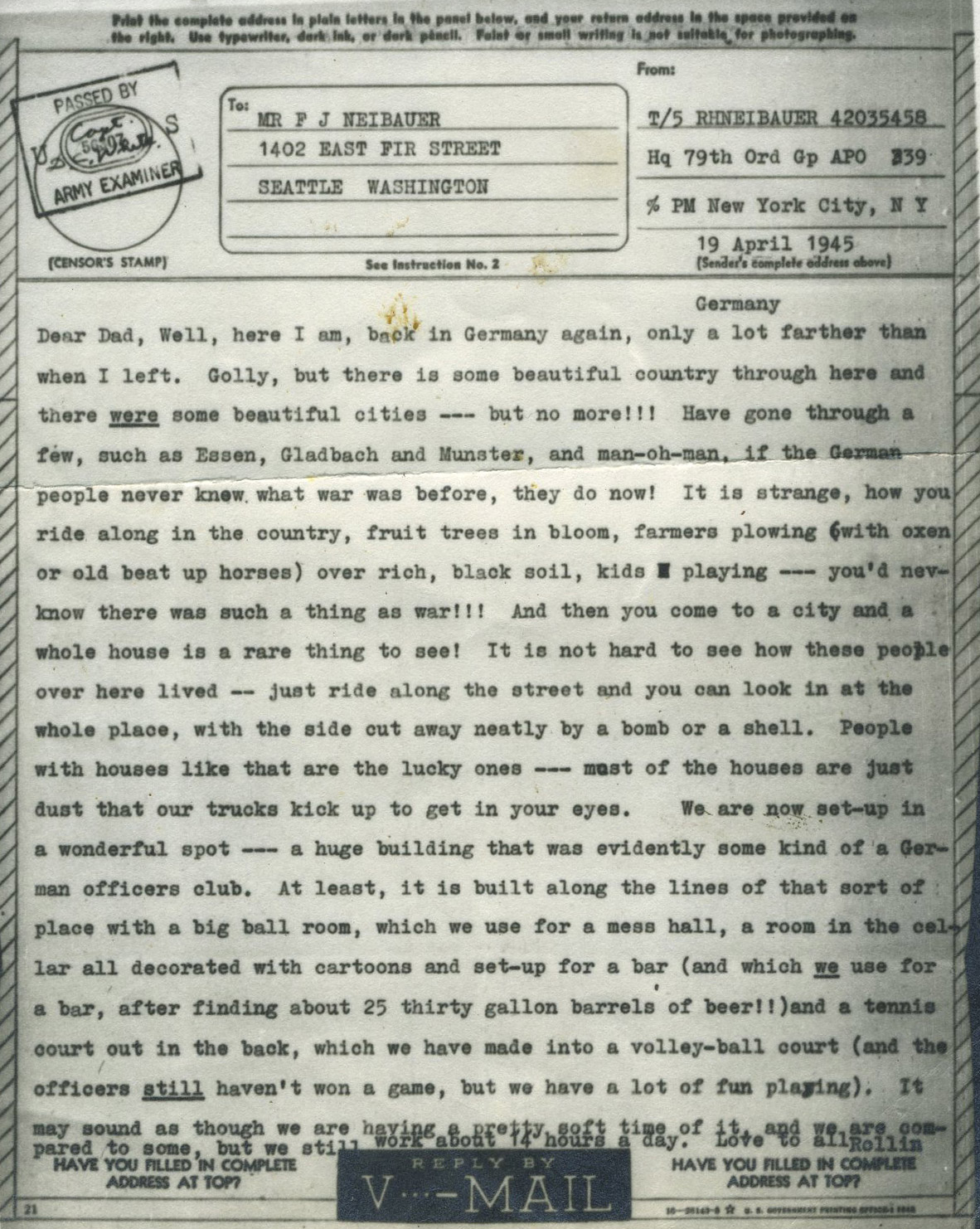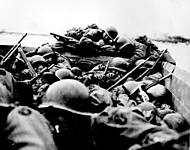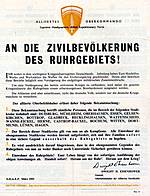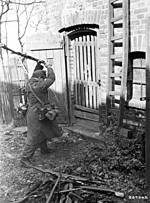
27 Sep The fruits of war, April 18 & 19, 1945
Dad’s unit has moved again and his descriptions of totally bombed out cities that used to exist are illustrative. He mentions Essen, Gladbach and Munster as being completely destroyed. And then, the cushy digs where they now reside – a former German officer’s club! I’m including a historical account of what occurred in the Ruhr region of Germany (Essen) at the end of the post.
18 April 1945 V-Mail to Mary
Germany
Good evening, honey, Received your Apr 4 quickie today and am wondering what the Chicago trip you mention is all about — evidently am missing a letter in here. My golly, but we have a swell set-up here. A Jerry officers club of some kind, I guess, and it’s a beautiful place! We have a big old-fashioned tap room down in the basement (for EM’s only – our dentist, who is a hell of a swell guy, is bemoaning the fact that officers are not allowed) and yesterday the colonel said for someone to go out and get some beer (and when the col. says something, it is done — and quickly) so some of the boys went out and came back with about 20 barrels of beer, or about 450 gallons for about 50 men. I think it should last us a few days, ANYway! We have a huge green lawn (surrounded by shrubs, and with walks and little nooks with tables and chairs (and a tennis court in back which we have turned into a volley-ball court, where we have some fine games with the officers (who still haven’t won a game — heh heh heh). Did I tell you that we now have three crazy Russian gals for our KP’s? One of them is the original gravel-throat Girtie — what a voice! Don’t speak a word of English, of course, so we have a lot of fun. I’m on guard tonight, so must go up and try to catch a bit of sleep before I go on again from one till three. did I tell you that I had visited Essen and Gladbach? Criminy, what pounding those cities took!! Nothing but rubble, wherever you look. Me, I’d rather look at you and Miss K, whom I miss & love,
Pappy
19 April 1945 V-Mail to Frank Neibauer
Germany (typed)
Dear Dad, Well, here I am back in Germany again, only a lot farther than when I left. Golly, but there is some beautiful country through here and there were some beautiful cities — but no more!! Have gone through a few, such as Essen, Gladbach and Munster, and man oh man, if the German people never knew what war was before, they do now! It is strange, how you ride along in the country, fruit trees in bloom, farmers plowing (with oxen or old beat up horses) over rich, black soil, kids playing — you’d never know there was such a thing as war!! And then you come to a city and a whole house is a rare thing to see! It is not hard to see how these people over here lived — just ride along the street and you can look in at the whole place, with the side cut away neatly by a bomb or a shell. People with houses like that are the lucky ones — most of the houses are just dust that our trucks kick up to get in your eyes. We are now set up in a wonderful spot — a huge building that was evidently some kind of a German officers club. At least , it is built along the lines of that sort of place with a big ball room, which we use for a mess hall, a room in the cellar all decorated with cartoons and set up for a bar ( and which we use for a bar, after finding about 25 thirty gallon barrels of beer!!) and a tennis court out in the back, which we have made into a volley ball court (and the officers still haven’t won a game, but we have a lot of fun playing). It may sound as though we are having a pretty soft time of it, and we are compared to some, but we still work about 14 hours a day. Love to all Rollin
THE RHINE CROSSING
On 7 March 1945 troops of the First US Army captured the Ludendorff bridge at Remagen nearly undamaged. The immediate crossing of the Rhine and the establishment of a bridgehead at Remagen created the starting position for the US Army’s following operations against the German hinterland. The conquest of the “armory of the German Reich”, as the Ruhr area was called both on the German and the Allied side, thus came within reach.
In connection with the allied airborne and ground operations “Plunder” and “Varsity”, British-Canadian and American troops then crossed the Rhine on a broad front in the Wesel-Dinslaken area between 23 and 25 March 1945. After the Rhine crossing the British troops marched toward Elbe and Northern Germany. The Ninth US Army penetrated at the northern part of the Ruhr district. At the same time the First US Army advanced from the south out of the Remagen bridgehead over the Sieger – and Sauerland regions in the direction of the Ruhr area.
According to the Allied planning decided upon by General Eisenhower on 25 March 1945, the Ruhr area was to be enveloped in a pincers movement and the units of the German Wehrmacht remaining there were to be encircled. The Americans at first counted on heavy street fighting in the ruins of the Ruhr’s cities.
The defense efforts of the German military, however, turned out to be in vain. Beside regular troops numerous units of the “Volkssturm” und “Freikorps Sauerland” were present. It consisted of provisional trained men and young people. The “final victory” – slogans of leading National Socialists turned out to be hollow phrases in the last weeks of the war, more than ever before.

“DEATH ZONE” OF THE RUHR
Between 20 and 28 March 1945 there occurred for the last time especially heavy air attacks on northern Germany as well as on the Ruhr area and its surroundings. In leaflets the Allied high command warned the population against staying in the rubble of destroyed big cities that the Allied leatfleats called the “Death Zone of the Ruhr”.
German anti-aircraft guns and fighter planes the Allied bomber units hardly needed to fear in the last weeks of the war. The heavy four engine bombers flew in as if on parade and dropped their bomb carpets with a hitherto barely imaginable precision.
The military value of these attacks was doubtful at this time, however, actually equal to zero. This is clearly shown by the example of the old bishop city of Paderborn, the medieval old town of which had until then made it through the war relatively undamaged.

A heavy British area bombing on 27 March 1945 turned the medieval inner city into ashes and rubble. More than 330 inhabitants lost their lives in this last area bombing of a target in the Ruhr region. The actual target had been the railway installations, but at this time the railway traffic in this region was already completely paralyzed.
COLLAPSE OF THE DEFENSE IN THE RUHR
On 1. April 1945 the Ruhr area was encircled by American troops at Lippstadt. In the North of this region British-Canadian troops and in the south American units penetrated further into the hinterland. Inside the “Ruhr pocket” about 320.000 German soldiers of Army Group B as well as 4 million civilians had been encircled.


While the main battle events of the “Western Front” gradually became transferred to northern and central Germany (“… on the way to Berlin”), American troops compressed the Ruhr pocket to a few kilometers. On 12. April 1945 there finally began an operation for the splitting of the combat area.
From the south, coming out of the Sieger- and Sauerland regions, strong forces of the US Army split the Ruhr pocket into two parts in the Hagen-Witten area. The smaller easterly part in the area of Iserlohn had to capitulate on 15 April 1945. In Hagen and Limburg the fights lasted until 17 April 1945.
The partial pocket in the area of Düsseldorf only stopped fighting on 21 April 1945 because General Field Marshal Model had until the last (his suicide) stuck to Hitler’s orders. In the face of obvious defeat, he thus still sacrificed numerous German soldiers and civilians to the mad orders to hold out issued by his “Führer” and to his own “officer’s honor”.



No Comments